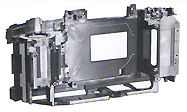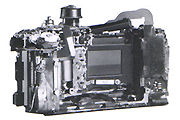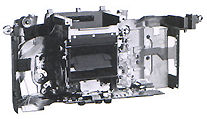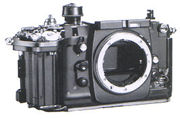 | Despite it was an electronic camera but just like strong tradition possesses in any predecessors, Nikon F4 was also being built to take worst punishment one would expect how a professional class SLR should be. Although those days, both the mechanical Nikon F and Nikon F2 have pathed the way to define what is ruggedness and reliability in a top class pro-calibre SLR camera but I think we have a lot to thank for in the Nikon F3 which was the first Nikon F-single digit series model to go electronic.
|
The bare basic aperture priority AE and manual exposure control was essentially merging the Nikon FE with dependability of the previous Fs - but the underlying fact was the hugely successful first attempt to let users experiencing full advantage of electronic camera offers in professional photography. The precision and reliability element in the F3 has proven to be unquestionable even to the most demanding pros and thus smoothly paths the way for easy acceptance as well as expectation of how a next generation of the Nikon F4 would be.
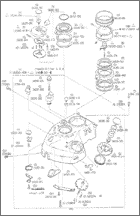 | 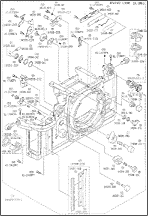 | Naturally, in comparison with the largely conservative F3, Nikon F4 was almost like a quantum leap in applied mechanical and electronic engineering (I think most would presume since it is a electronic camera and there are only flexiboards inside, no - you will be amazed as there are 1,750 parts to make up a standard Nikon F4 body and every inch of space is also being fully utilized to house all these sensitive components).
Don't believe ? Click to see two scanned images with just the top right hand panel and another is a front section assembly of the camera (without even shown the lens mount assembly. |
Well, be able to screeze in all these essential components (the Multi-Meter Finder itself is consists of another 200 parts and the shutter unit, 200 parts) inside a relatively compact camera body is one thing but to ensure this camera can also deliver equaling a previously set-standard in durability and reliability of how a Pro-level SLR should be judged while at the same time, ensuring all it has to offer in various sophisticated features will function flawlessly is another big task during its designing stage. Just like the F3, the priority is how to protect all the sensitive electrical and electronic components within. So, it started with the Nikon F4 backbone which uses a solid aluminum-alloy die-cast body structure for superb strength, rigidity and resistance to corrosion. The die-cast body consists of a front body, rear body, finder mounting section and hand grip.
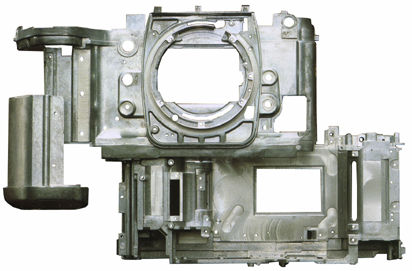 | To ensure stability when changing numerous accessories, including lenses, finders and focusing screens, the Nikon F4's body has to be rugged, yet manufactured to exacting tolerances. Therefore, Nikon selected a special alloy of Copper Silumin Aluminum, which is less susceptible to blowholes during manufacture. This alloy, the same as that used with the Nikon F3 has a high tensile strength of approx. 33.5kg/mm (475.5 lb/in (475.5 lb/in ) ! ) ! |
NOTE: Come to think of it - What Nikon has provided in the F4's body structure is hard to rivaled by others in terms of quality aspect - many other rivaling brands took short cut in this area. For an instance, Canon's EOS-1 (for that matter, virtually all Canon introduced that time was using 'industrial strength carbon fibre reinforced" polycarbonated body to the camera but Nikon still persistently thinking metal structure is more vulnerable to shock and resistant.. Nikon was not wrong, Canon 's current flagship EOS-1v has finally reverted back to metal construction - after two generations of the EOS-1 series !
 | The thick-walled body configuration has been designed to endure vibrations. The average thickness of the casting wall is 1.3mm for the front die-cast and 1.2mm. for the rear die-cast. The box-shaped construction with bridges and the hollowed wall design increase strength against shocks. In addition to the main body, the mounting section of standard Multi-Meter Finder and the interchangeable hand grip have also been die-cast for maximum rigidity. |
All this assures that the precision parts, microelectronics and optical parts inside the body are dependably protected. As the standard Multi-meter Finder DP-20 is an important system component in the Nikon F4, the microelectronics of the standard Finder's pentaprism are also being protected by a special double-reinforced plastic covers. Externally, the camera also was laminated with a rubber compound body surface which doubles as a shock absorber. In case of shock, the very firm yet resilient material used has a very unique character as it will instantly "transformed". then instantly "regains" its original shape. That means less possibility of external damage and of coursel minimum internal shocks. The same threatment of this special coated material is also used on rear portion of the camera back as well.

In fact, the quality aspect of the camera was undoubtedly high. It follows a good Nikon tradition of the F-series bodies which were hallmarked for its extremely durable and reliable in camera performance / handling. As even during at the stage of assembly - each part module is handled by specialized Nikon factories in Japan. For an instance, assembly of the shutter unit was at Nikon own's Ohi Plant, Tokyo; the pentaprisms for the viewfinder are manufactured at the Nikon Tochigi Plant, north of Tokyo, where Nikkor lenses are also manufactured. The FPC boards are assembled, using a highly advanced laser trimming system and other advanced equipment, at the Nikon Sendai Plant in northern Japan. This production system ensures that each module of the Nikon F4 is made by highly specialized experts.







